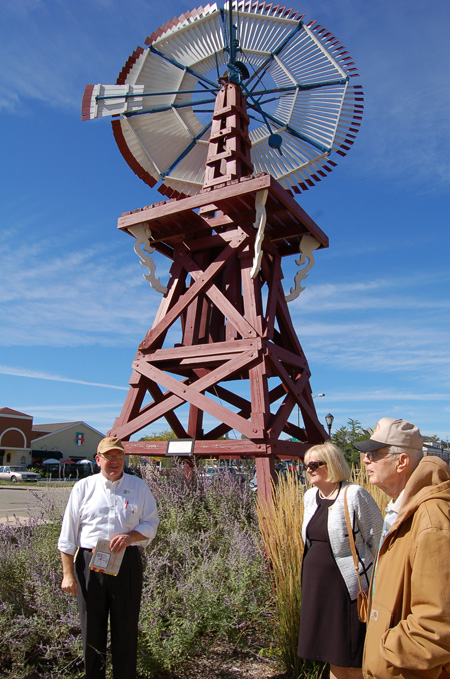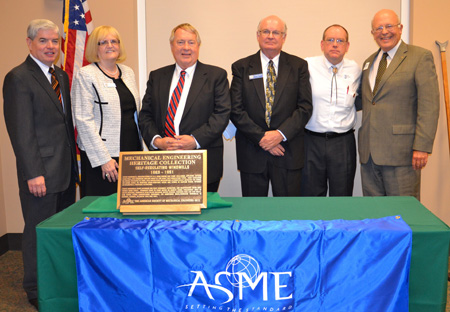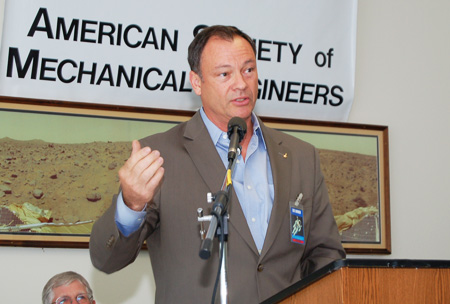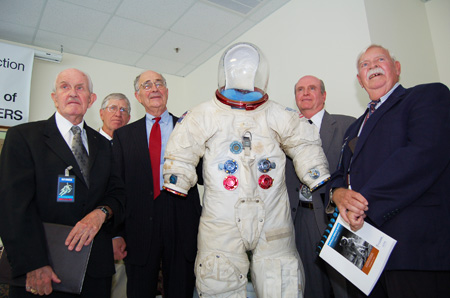Windmill Collection and Apollo Space Suit Added to ASME’s Landmarks Roster
Windmill Collection and Apollo Space Suit Added to ASME’s Landmarks Roster

Earlier this month, ASME designated a collection of early windmills and the legendary Model A7L Apollo space suit as the two latest historic mechanical engineering landmarks, bringing the total number of ASME landmarks to 255.
This has been a busy couple of months for ASME’s History and Heritage (H&H) Committee, which oversees the ASME landmarks program. Just last month, the committee designated two other landmarks, the Big Surf Water Park Wave Pool and the Titan Crane, in ceremonies held in Arizona and Scotland, respectively.
On Sept. 14, the Society designated landmark status to a collection of 17 reconstructed windmills — nine of which are in operation — during a ceremony in Batavia, Ill. From 1863 to 1951, Batavia, often referred to as “the Windmill Capital of the World,” was home to six local windmill makers, including U.S. Wind Engine & Pump Co., which built the nation’s first mass-production facility and held 27 patents on windmill design. Incorporating innovative design ideas for the blades and wheels, Batavia’s windmills were used to pump water for livestock and plants and also played a major role in western expansion, allowing settlements to grow beyond the confines of lakes and rivers.

The Batavia windmills “were designed for easy assembly, operation, and maintenance using only simple hand tools,” according to the plaque that was presented to the town during the ceremony. In the landmark designation, ASME also cited the windmills for the self-regulating capability of their systems, which automatically adjusted the wheel and blade angle to maintain constant speed and power in varying winds.
The 17 windmills honored at the ceremony were gathered from various sites throughout the country during a local drive themed “Bringing Them Home,” initiated in 1994. Each of the windmills was reconstructed locally by windmill enthusiasts and restorers.
During the presentation of the landmark plaque, ASME Past President Victoria Rockwell paid tribute the engineering innovation behind the windmills. “Engineers spend countless hours in an effort to find solutions to some of the world’s greatest challenges,” she said. “We hope that the time put into researching, evaluating and providing solutions to these challenges will help improve to the quality of life. With any luck, our contributions will be lasting, impactful and will go on to make our world a better place for generations to come. Daniel Halladay, the visionary engineer responsible for the Batavia Windmills, exemplifies that which makes engineering such a special endeavor. Batavia indeed has influenced a generation of engineers and entrepreneurs, and it is important that we take time to recognize their historic accomplishments.”

Rockwell also thanked the Fox Valley Section for hosting the ceremony, Fox Valley Section Director William Shust for preparing the nomination materials and helping coordinate the ceremony, and the late Gerald Moyar for initiating the windmill collection’s nomination for ASME landmark status. In addition to former President Rockwell, ASME was represented at the event by Thomas Fehring, vice chair of the ASME H&H Committee.
On Sept. 20, ASME Past President John Parker officiated a ceremony at ILC Dover Inc. in Frederica, Del., during which the Model A7L space suit was named an ASME landmark. The space suit, created at ILC Dover, was made famous by Astronauts Neil Armstrong and Buzz Aldrin during their Apollo 11 mission to the moon and worn by American astronauts on 10 other Apollo missions.
ILC designed the suit, which consists of a torso assembly that integrated the arms, legs, and boots into a single pressurized garment. The spacesuit features a specially engineered ventilation system to allow the flow of pure oxygen, signal telemetry to monitor heart rates and other conditions, a system for the continuous flow of cool water, and a thermal micrometeoroid outer layer to protect against solar radiation and other hazards.

The space suit, which was worn on Apollo missions between 1968 and 1972, may have been complex from a design engineering standpoint, but it was also a highly practical garment that allowed NASA’s astronauts the mobility and flexibility to walk the lunar surface, handle cameras and other equipment, and manage delicate research tasks.
“The Model A7L space suit protected Apollo astronauts from the harsh conditions of space while providing good mobility, particularly on the lunar surface,” reads the inscription on the landmark plaque presented to ILC at the ceremony. “Each suit served as an independent, personal spacecraft that furnished all life support, hazard protection, communication, and comfort features needed by an astronaut.”
During the ceremony, Parker said of the suit and the engineering achievement of ILC, “Douglas Lantry, author of Man in Machine, an essay on the history of technology called the Apollo Suits, ‘likely the most complex clothing ever made, and they share characteristics of both garments and machines.’ The work done by ILC is the type of engineering that indelibly moves our culture. For the space suit image is one that, according to Mr. Lantry ‘has become a familiar and enduring symbol.’”

Scott Davidson, a member of the ASME Delmarva Subsection, nominated the space suit for its ASME landmark designation. Robert Woods, H&H Committee member and Mechanical Engineering magazine contributor, and Raymond Jackson, chair of the Delmarva Subsection also attended the landmark ceremony, which was coordinated by the Delmarva Subsection and ILC Dover.
To learn more about the ASME Historic Mechanical Engineering Landmarks program, visit www.asme.org/about-asme/who-we-are/engineering-history/landmarks.




